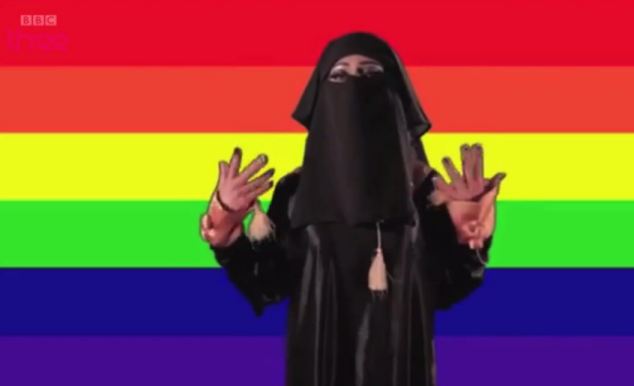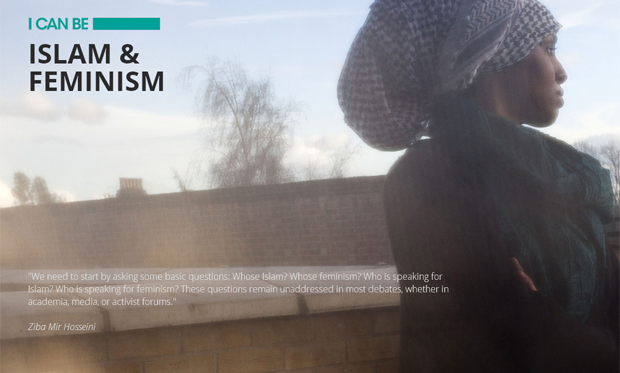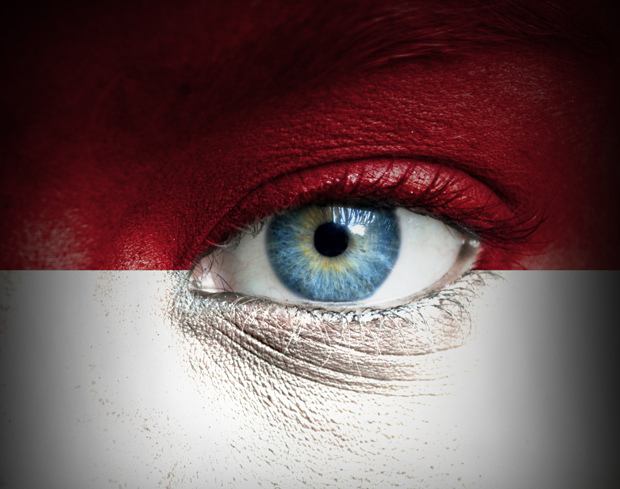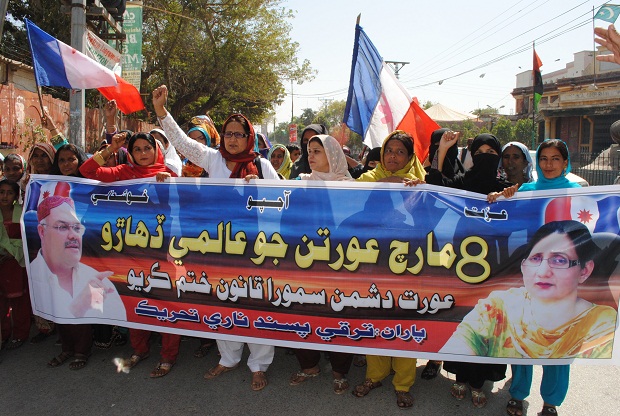14 Apr 2014 | News, Religion and Culture, United Kingdom

Asif Quraishi, better known as drag queen Asifa Lahore, sits unassumingly in a TV studio. “One question I’d like to ask”, he says, “is when will it be all right to be Muslim and gay?”
The programme is Twitter-powered BBC Three debate series Free Speech, whose host Rick Edwards (of Tool Academy and, unexpectedly, Cambridge) makes Nicky Campbell seem subdued, and where no thought is too complex for 140 characters. Producers, show name notwithstanding, spiked the question from a previous edition when officials at Birmingham Central Mosque, where Free Speech filmed on March 13, “expressed deep concerns” about gay Muslims being discussed. The speed at which showrunners acquiesced, postponing the segment, speaks to a wider trend.
The first guest to comment, kufi-clad Portuguese convert Abdullah al Andalusi, calls condemning gay sex “the Islamic position” with a party leader’s certainty. It’s unsurprising: al Andalusi, who defends public segregation by gender and from whose talks women have been banned, seeks a nondemocratic “modern [Islamic] Caliphate” under sharia government, free among other things of “women wearing bikinis”, “the hijab being optional” and “men and women having identical inheritance and gender roles”. Al Andalusi rails in-studio against notions of “extremism”, declaring them a means of profiling “Muslims with orthodox beliefs”. He sees himself as holding these, and so apparently do programme-makers, since he speaks much more than Asif does.
The counter-extremist whose work he attacks, Lib Dem candidate for Hampstead Maajid Nawaz, is also in the room. (“I will speak out”, he tells the drag performer, “on your right to identify however you want.”) Nawaz too has been hounded by religious would-be censors, despite being a Muslim himself. This January, following the LSE’s attempts to ban it, he tweeted an image from the atheist web strip Jesus and Mo, commenting “This is not offensive and I’m sure God is greater than to feel threatened by it.” A subsequent Change.org petition calling for his sacking gained over 20,000 signatures, some with death threats attached. Though Nick Clegg eventually stepped in to condemn them, spokespeople told the press the party “urged all candidates to be sensitive to cultural and religious feelings”, and Nawaz – presumably after internal bickering – conceded in a joint statement with Mohammed Shafiq, head of the Ramadhan Foundation and leader of the witchhunt, that “images of the spiritual leaders of all religions should be deemed to be respectful”.
In February Shazad Iqbal, a hitherto unknown British Muslim, used a similar petition to demand YouTube remove Katy Perry’s “Dark Horse” video, in which an Ancient Egyptian turns to sand whose pendant, on close inspection, reads “Allah”. “Blasphemy is clearly conveyed in the video”, Iqbal wrote. “Such acts are not condoned nor tolerated.” While the offending necklace, which had to be indicated using photoshopped freeze-frames, was barely visible, tens of thousands of signatures poured in – today, the page boasts more than 65,000 – and Perry’s producers digitally obscured it.
Iqbal, who used his petition site to share evangelistic videos, gained a platform much like Iqbal’s and al Andalusi’s. All three, and countless more religious rightists, have sold themselves as commentators, “community leaders” and de facto spokesmen for Muslims (“men” is applicable here), grabbing the spotlight neither through skilled writing nor through views polls say are actually widespread. They owe their standing to officialdom’s mounting anxiety to please the most censorious believers, its instinct that those eagerest to cleanse the public sphere of blasphemy are those who matter most.
Recycled lines about a scaremongering anti-Muslim press over-reporting extremism come easily, but demagogues of this kind are media’s darlings; far from casting them as bogeymen, it heaps meetings with politicians, TV appearances and public validation on them. Nor is this pattern unique to Islam. In a 2012 speech for the National Secular Society, Pragna Patel of Southall Black Sisters cites the case of Behzti, a play by Gurpreet Kaur Bhatti which portrayed sexual violence in a Sikh temple. “Fundamentalists, but also so-called moderates,” says Patel, “took offence, protested and had the play removed”, theatre staff bowing to their demands. Leaders on the Sikh right, she says, stated once Bhatti entered hiding that if Labour’s Racial and Religious Hatred Act had existed at the time, it would have been used to censor the play.
Authorities sided with those attacking her, as they sided with Shafiq over Nawaz, al Andalusi and Birmingham Central Mosque over Quraishi, Iqbal over every Muslim undisturbed by Katy Perry. Reformists and minorities like them, as much as a free society, are casualties of this love for religious censors. If minor faiths, still mysteries in the public eye, need representatives, far better ones exist: A media that paints puritans and fanatics as mainstream forfeits its right to condemn them.
This article was posted on 14 April 2014 at indexoncensorship.org
25 Mar 2014 | News, Religion and Culture, Young Writers / Artists Programme

This month, British charity Maslaha launched the website “Islam and Feminism”– a new project which aims to unite the two belief systems. “Muslim women have the same core concerns as white, secular, British women: the workplace, discrimination [and] childcare” says the charity’s Latifa Akay, yet they have long been excluded from the feminist debate. This is what the project wants to change by promoting the idea that women of all religions can push for gender equality.
Inna Shevchenko, leader of topless protest group Femen, strongly disagrees. “I will never have a discussion about Muslim feminism because it doesn’t exist. It cannot exist. It’s oxymoronic.” Femen’s intolerance has seen them labelled as “white colonials” and “cultural imperialists” but the group’s real fault is the way it forces women into a mould, leaving no space for individualism.
In 2012, Femen protested against the International Olympic Committee’s collaboration with Islamist regimes. As a demonstrator was led away by police, she screamed “I fight for women who are not free. We are not free”. She had elected herself as spokesperson for women around the globe but the way she spoke for Muslims prompted backlash.
It seemed that many Muslim women did not want to be “liberated” by semi-nude activists. They felt Femen were patronizing and had done little research into the culture of Islam. The Facebook page “Muslim Women Against Femen” was founded and a series of selfies, emblazoned with slogans appeared – “hijab is my right”, “nudity does not liberate me” and “I do not need saving”. A feeling of resentment was prominent; these women did not want western ideals imposed on their faith.
Artist Sarah Maple considers this idea in her current exhibition, “God is a feminist”. Her work turns the tables on common perceptions of Muslim women as trapped and victimized. “In the West there is an obsession with being sexually attractive in a very limited and narrow way. I was looking at how this may be seen as a form of oppression and that there may be a freedom in covering up”.
Feminism should never be rooted in the idea of whitewashing society. Surely nothing is more backward than the mind-set; “to be free, you must look like me, think like me and live like me”. Equality is about giving all genders absolute choice, no matter their religion.
Recently it has become a trend for far right groups to hijack feminist rhetoric – alienating Muslims from feminist dialogue. During an anti-Islam rally in Munich, The Freedom Party’s Michael Stürzenberger furiously revealed to the crowd that Sharia instructs men to hit women. “We don’t want that in Bavaria!” he bellowed. Yet he is not concerned with women’s rights, instead he channels his efforts into spreading Islamophobia. He’s already lead over 100 anti-Islam demonstrations.
British groups like the English Defence League and the British National Party also rush to condemn Islam’s lack of feminist values. But their opinions in this area seem entirely self-serving, especially when they are associated with candidates like the BNP’s Nick Eriksen.
Feminism must separate itself from inflammatory politics. Instead, its focus should be on educating women and empowering them to make their own choices – making sure no one is trapped in any lifestyle. However freedom and tolerance should always be on the same side.
Feminism should mean that women can work in any industry, receive the same pay as their male colleagues and demand respect from their husbands, whether they wear the hijab or not. Of course Muslims can be feminist and their views should be welcomed into the debate.
This article was posted on March 25, 2014 at indexoncensorship.org
6 Feb 2014 | Indonesia, News, Politics and Society, Religion and Culture

(Photo illustration: Shutterstock)
Listening to Indonesian politicians campaigning for this year’s elections you could be forgiven for thinking that freedom of religion is not a problem in the country with the world’s largest Muslim population and that all is well when it comes to interfaith relations.
You couldn’t be more wrong.
Just because freedom of religion rarely makes an election theme doesn’t mean that everything is all right. And don’t take the word of President Susilo Bambang Yudhoyono either, who in May received an award from the New York-based Appeal of Conscience Foundation for promoting “religious tolerance”.
Speak instead with the followers of Ahmadiyah, the Muslim Shias, various Christian denominations and other minority religious communities. They will tell you, mostly in private, of their fears along with stories of persecution and harassment, sometimes involving violence by hard-line Islamic groups, and often with the tacit approval of the government.
To religious minorities, the fact that no politician has bothered to take up the issue and that the majority of Sunni Muslims are keeping silent, Indonesia is anything but tolerant. The problem is growing due to this official and public denial in Indonesia that it even exists.
The religious minorities also know they are missing out on the opportunity to make their case before the nation during this election year because most politicians would consciously avoid talking about religious freedom in their campaigns.
Indonesians will be voting twice this year, first for their representatives in April and second for their president in July. A new government will be installed October.
This will be the nation’s fourth democratic elections since it deposed strongman Suharto in 1998. Indonesia has since won accolades as one of the few successful countries to make the transition from authoritarianism to democracy.
Its leaders often boast that Indonesia is the world’s third largest democracy after India and the United States, and the largest democracy among Muslim-majority countries. Religious tolerance has even been touted as one of the recipes for the country’s success.
Indonesian diplomats have been involved in establishing and promoting interfaith dialogues at bilateral, regional and international levels. In August, Indonesia will be sure to showcase its democracy and religious tolerance when it hosts the annual meeting of the UN Alliance of Civilizations.
Indonesia’s democracy, however, has one big flaw: It is quickly turning into a simple majority rule, and this means that when it comes to religious issues, the voices of religious minorities are drowned out by the voice, or even the silence, of the Muslim majority.
While religious moderation still prevails, religious minorities feel that often the Muslim majority stretches their tolerance too far to include tolerating religious intolerance. Their silence in the face of reported religious persecution is disturbing.
Muslims, predominantly Sunnis, make up about 86% of Indonesia’s population of 250 million.
Religious minorities coming under persecution have learned that sometimes it is better to keep silent and not draw too much public attention to themselves. In some instances, those who have spoken out against their ill-treatment have earned the wrath of more Muslims and the government.
Typically the victims were blamed and came off worse. Some Ahmadiyah, Shiah and Christian leaders have gone to jail on various pretexts. Charges have ranged from blasphemy for preaching their beliefs to building permit violations in connection to places of worship. Worst of all, some religious minorities have been targeted for disturbing the peace by their mere existence.
Hundreds, if not thousands, of Ahmadis have been lingering in makeshift shelters for years in East Java and West Java because their homes, schools and mosques have been vandalized or even razed to the ground by radical Islamic groups.
Dozens of Shia followers in East Java are living in shelters after they were hounded out of their village in 2012. The provincial government has told them that they would be able to return on condition of renouncing their Shia beliefs and “return to the right path”.
A Shia leader last year saw his jail term doubled to four years by the High Court and later upheld by the Supreme Court for spreading his teachings, something that the court considered blasphemous to the “real Islam”. Two men who led the mob to vandalize his house and attack his followers in Sampang received eight months imprisonment.
This is a repetition of the 2011 controversial court verdicts that sentenced an Ahmadiyah follower, whose house in the Cikeusik village in West Java was raided in a fatal attack, to six months imprisonment, the same or higher than what the assailants got.
Last year also saw Palti Panjaitan, a priest with the HKBP Filadelfia Christian church in Bekasi, just outside Jakarta, tried in a court for “assailing” a Muslim leader who had joined a mob to taunt and harass him and the Church followers outside his church.
This has resulted in the congregations of HKBP Filadelfia, and that of GK Yasmin Christian church in Bogor, another township adjacent to Jakarta, conducting their Sunday prayers outside the Presidential Palace in Jakarta every week in protest of the government’s failure to protect and uphold their rights to conduct services.
President Yudhoyono has obviously not heard their prayers yet.
In both cases, the local government has refused to reopen their churches in defiance of Supreme Court rulings that supported the presence of the church and the right of the people to conduct prayers there.
Religious minorities in Indonesia may have given up hope on President Yudhoyono helping their case. But at least they have some comfort knowing that, come October, a new president will be in power: Yudhoyono cannot return for a third term.
Freedom of religion may not be an election issue, but no doubt the new president will be reminded that their oath of office includes a pledge to uphold the constitution, which clearly stipulates an obligation to guarantee and protect freedom of religion.
Democracy still gives some hope.
This article was originally published on 6 February 2014 at indexoncensorship.org
24 Jan 2014 | News, Pakistan, Religion and Culture

Hindu women protest in favour of Rinkle Kumari who was forced to convert to Islam in 2012 (Image: Rajput Yasir/Demotix)
December 21 will forever be etched on the memory of Sapna and her family. Belonging to a poor Hindu family, Sapna and her older sister Sabita were teachers in a neighbourhood school in Paharipura, Peshawar, the capital city of Khyber Pakhtunkhwa province. They were the sole breadwinners for the family after their father, who worked for Radio Pakistan, retired four years ago.
On that cold wintry day Sabita stayed after school to give extra tutoring while Sapna walked home alone. During her walk a car suddenly pulled up alongside her- out jumped a man who placed a cloth doused in an unknown chemical over her face. Sapna passed out.
When she regained consciousness she found herself in unfamiliar surroundings. A man, whom she had never seen before, asked her to marry him. But first Sapna would have to convert to Islam.
On her refusal, the man placed the intoxicant-doused cloth over her nose and she fainted once again. This routine carried on for 16 days.
Sapna narrated her account of the kidnapping to the judicial magistrate earlier this month after she was rescued.
“The police traced her through a phone call she made to us asking us to rescue her,” Ramesh Kumar, her brother-in-law told Index on Censorship during a phone interview. He, along with his wife, Sapna’s older sister, had accompanied the police and found her in a village in Bahawalpur, in Punjab province some 680 km from Peshawar.
“Unfortunately, the person who kidnapped her, Zahid Nawaz, got a tip-off and escaped,” said Kumar. Nawaz wasn’t a complete stranger to Sapna. Kumar believes that his sister’s kidnapper had managed to ensnare Sapna by calling her a few times before the snatching took place.
“When he learnt that she was a Hindu, he told her that he didn’t have a sister and looked on her as one,” he added.
Despite being the first case of its kind in the area Sapna’s kidnapping has spread fear among the Hindu community in Peshawar- since the day her sister was abducted Sabita has not been allowed to step out of her house.
However, the kidnapping of Hindu girls is nothing new in other parts of the country. According to Ramesh Kumar Vankwani, head of the Pakistan Hindu Council and a legislator: “We hear of three to four such cases every month from Sindh [province].”
More worrisome to the independent Human Rights Commission of Pakistan (HRCP) is the forced coercion of these Hindu girls to Islam before marriage takes place. The majority of these cases have been reported in the Sindh area with the HRCP calling it one of the “most outrageous human rights violations one has to deal with.”
I.A. Rehman, of the HRCP, blamed both the state and society for the escalation: “Both are getting more and more caught in the frenzy of religiosity, a process accelerated by the increase in Al-Qaeda/Taliban/Salafi influence on Pakistan’s Muslims.
“Hard-line Islam is supposed to liquidate non-Muslims and Shias and people belonging to other sects, such as Barelvis who enjoy music and visit shrines,” referring to the recent killings of devotees at a sufi shrine in Karachi earlier this month.
At the same time, he pointed out, the “zealots” among the society hoped to secure a “place in paradise” by converting non-Muslims to Islam. Hindus account for just over one per cent of the Pakistan’s population of 180 million.
Rehman deplored how the judiciary had been unable to intervene in such cases, noting how such lack of action reassures the culprits and depresses the communities of the victim.
Most religious minority members sitting in the assemblies are selected, as opposed to elected, and are therefore not the true representatives of their communities. Instead, they often toe the party line that has given them the ticket to their seat.
For their part, people like Vankwani say: “The main political parties pay lip service to our problems but have consistently failed to protect our lives or our rights,” arguing that until fair representation of minorities occurs in the assemblies their issues will never be resolved.
Amar Guriro, a journalist from a Hindu community, had a different take on the issue of coerced conversion. “There are cases where girls have converted of their own will or have eloped because, unless their parents can pay the heavy dowry that is demanded by the groom’s side, they cannot be married off,” he said.
Muslims have often been accused of preying on Hindu girls of marriageable age, forcing families to marry off their daughters at an earlier than desired time. “If they don’t there is a danger they may be kidnapped and asked to renounce their religion,” Guriro reported.
According to Amarnath Motumal, a lawyer with the HRCP, young Hindu girls may easily get “influenced” by their Muslim paramour: “In a country where even in schools Islam is the only religion taught and where religious freedom is negligible, young minds can easily be moulded.
“In Pakistan a Muslim woman cannot be married without the consent of the waali (her guardian — a father, uncle, or brother). Why didn’t the same hold true for the Hindu girl who had converted?”
Motumal has appeared in several cases of forced conversions. He told Index that during these hearings there is immense pressure on not just the young girls but also the judge as hundreds of protesting clergy can gather outside the courtroom. “The girls often do not have the courage to speak how or what they feel about the predicament they are in. And if the woman converted of her free will, why is she not allowed to meet with her parents?” he asked.
In 2012, the cases of Rinkle Kumari from Ghotki and Dr Lata Kumar in Karachi were taken up by the court after concerns arose in the media that they were forcefully converted to Islam.
Today, Motumal said, both women live with their respective Muslim husbands, but, he added: “They may be apparently happily married, but who knows what is going on in their hearts. They know what their fate will be if they have a change of heart and mind — they may be shunned by their own community and never find a match!
“Most believe themselves to have been polluted beyond redemption and prefer to stay with their abductors to returning home.”
This article was posted on 22 January 2014 at indexoncensorship.org




